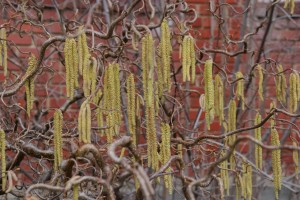Contorted filbert (Corylus avellana ‘Contorta’), aka Harry Lauder’s walking stick, is an 8-10 foot tall shrub. It grows in average well-drained acidic or mildly alkaline soil and thrives either in full or partial (6 hours) sunlight. Contorted filbert is usually sold in a grafted form.
It is also called corkscrew hazelnut because most branches, twigs and leaves display a twisting or spiraling nature. Showy yellowish brown male catkin flowers grow to 2-3 inches in length in late winter and early spring. Tiny female catkins are barely visible. Contorted filbert does not bear fruits (nuts).
The light green almost circular leaves (2-3 inches in diameter) are double-toothed along the leaf margin. The foliage turns a drab yellow in the fall. Following leaf abscission, the curlicue branching provides considerable autumn and winter interest.
Contorted filbert has no serious insect or disease problems. Susceptibility to crown gall is often associated with a poorly drained site. Occasional scale insect infestations may be eradicated with 1-2 applications of dormant oil in the winter months before new leaves emerge. Root suckering may become a maintenance nuisance. These straight growing (not twisted) suckers tend to eventually dominate the entire shrub and should be removed.
‘Red Majestic’ is a new contorted filbert. The new spring growth emerges with burgundy red tint which bleaches out to a dark green foliage by late May.


 Posted in
Posted in 
